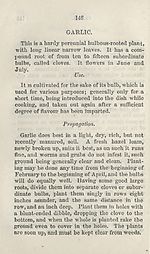Occupations > Abercrombie's improved practical gardener; with a monthly calendar for the flower garden
(151)
Download files
Complete book:
Individual page:
Thumbnail gallery: Grid view | List view

HORSE RADISH.
147
Taking the Crop.
The bulbs will oe full grown by the end of
July or beginning of August, and the leaves
changing colour and appearing decayed is the
criterion of their maturity, and may be taken up
with safety. The leaves and stalks must remain
to the bulbs, which must be spread in the sun to
dry and harden, after which they must be tied
up in bundles and hung up for use as required.
They will remain good for the following spring
and summer use.
HORSE RADISH.
This a hardy perennial, the leaves of which
are large, oblong, sometimes smooth, and at
other times notched at the edges; on the stem
they are sometimes pinnatified; the flowers ap¬
pear in May and June, are white, and are in
loose panicles.
The root scraped into shreds is a well-known
accompaniment of Old English Roast Beef; it is
also used in salads in winter, and in sauces, and
sometimes eaten raw.
Propagation and Culture.
An open situation, and a deep, soft, sandy
loam, neither very dry in summer nor wet in
winter, suits the horse-radish best. The ground
147
Taking the Crop.
The bulbs will oe full grown by the end of
July or beginning of August, and the leaves
changing colour and appearing decayed is the
criterion of their maturity, and may be taken up
with safety. The leaves and stalks must remain
to the bulbs, which must be spread in the sun to
dry and harden, after which they must be tied
up in bundles and hung up for use as required.
They will remain good for the following spring
and summer use.
HORSE RADISH.
This a hardy perennial, the leaves of which
are large, oblong, sometimes smooth, and at
other times notched at the edges; on the stem
they are sometimes pinnatified; the flowers ap¬
pear in May and June, are white, and are in
loose panicles.
The root scraped into shreds is a well-known
accompaniment of Old English Roast Beef; it is
also used in salads in winter, and in sauces, and
sometimes eaten raw.
Propagation and Culture.
An open situation, and a deep, soft, sandy
loam, neither very dry in summer nor wet in
winter, suits the horse-radish best. The ground
Set display mode to:
![]() Universal Viewer |
Universal Viewer | ![]() Mirador |
Large image | Transcription
Mirador |
Large image | Transcription
| Antiquarian books of Scotland > Occupations > Abercrombie's improved practical gardener; with a monthly calendar for the flower garden > (151) |
|---|
| Permanent URL | https://digital.nls.uk/121883031 |
|---|
| Description | Thousands of printed books from the Antiquarian Books of Scotland collection which dates from 1641 to the 1980s. The collection consists of 14,800 books which were published in Scotland or have a Scottish connection, e.g. through the author, printer or owner. Subjects covered include sport, education, diseases, adventure, occupations, Jacobites, politics and religion. Among the 29 languages represented are English, Gaelic, Italian, French, Russian and Swedish. |
|---|

